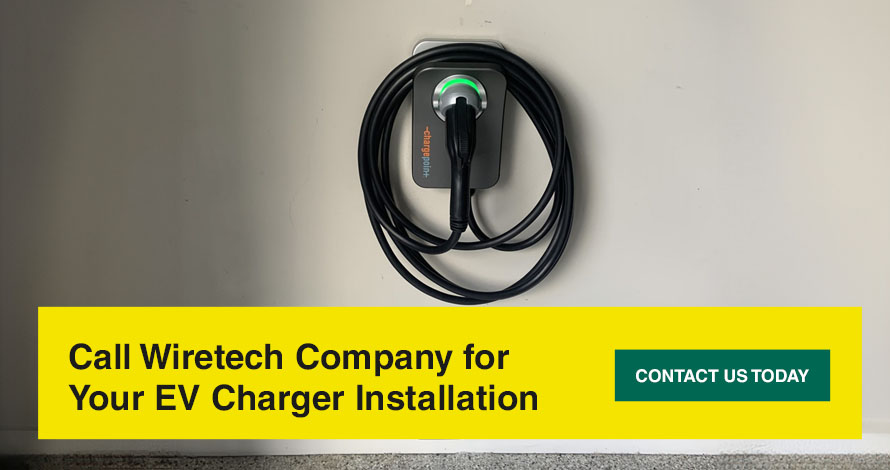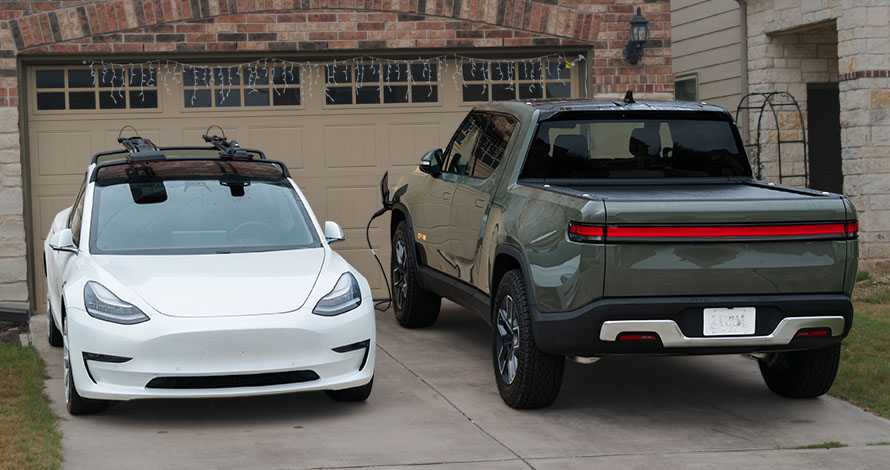
The average car spends most of its life parked, so why not make the most of your investment by using your EV battery for more than driving? Bidirectional charging has been a hot topic among EV owners and auto enthusiasts for several years now, and it’s sure to get even more buzz as more manufacturers begin releasing vehicles with this capability.
If you’re in the market for a new EV, this topic is likely already on your radar. To help you decide if it’s a priority, we’ll explain everything you need to know about bidirectional EV charging so you know what to expect.
What Is Bidirectional Charging?
Unlike unidirectional charging, where the energy only flows into the device plugged into the charger, bidirectional charging allows you to redirect electricity flow so your vehicle can charge other devices and even other vehicles using the energy stored in its battery.
Bidirectional chargers are similar to bidirectional inverters, which have been available as a backup power option for several years now. These devices enable you to convert stored direct current (DC) electricity to alternating current (AC) for electronic devices and household appliances.
How Does Bidirectional Charging Work?
While the technology is complex, it applies simple electrical concepts. Traditional unidirectional charging follows this process:
- AC electricity flows into the vehicle from the charger.
- The incoming AC converts to DC electricity.
- The battery stores the DC electricity until it’s time for use.
In bidirectional charging, the DC electricity can revert to AC and flow out of the vehicle into a connected device, which can power anything from a camp stove to your entire house.
Requirements for Bidirectional Charging
If you want to take advantage of two-way charging, you’ll need several pieces of specialized equipment to get started:
- A vehicle that supports two-way DC charging
- A bidirectional EV charger
- A two-way charging adapter for recipient devices and appliances
You’ll also need to install smart charging technology for bidirectional charging to work correctly — most of the time, this software should come with your purchase of a bidirectional charger. Smart charging allows you to use a mobile app to control:
- When the vehicle starts and stops charging.
- The speed at which your car charges.
- In which direction the electricity flows.
Bidirectional charging equipment is a significant investment. If you have any questions about the specific devices you should purchase for use with your EV, consult with your dealer or owner’s manual to make sure you’re selecting the right components.
Types of Bidirectional Charging
At the moment, most bidirectional-capable EVs are only capable of one or two types of charging. We’re likely to see this change as technology advances and manufacturers add more functionality.
Bidirectional charging capabilities that are currently available include:
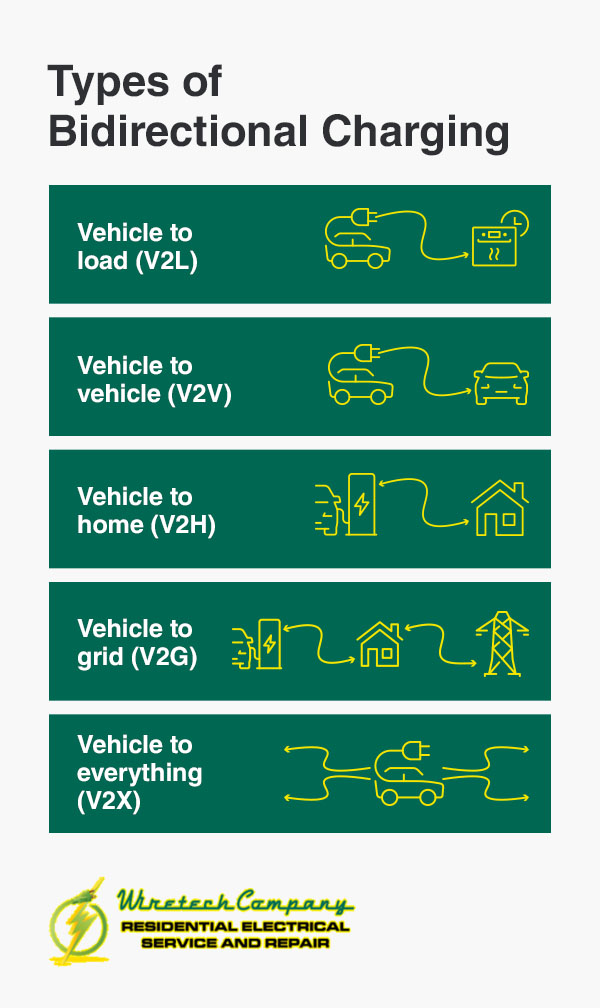
- Vehicle to load (V2L): The battery supplies energy to electrical appliances and devices like camp stoves, coffee makers and power tools. V2L charging is currently the most widely available form of bidirectional charging, though it often requires specialized adapters to make devices compatible with your car.
- Vehicle to vehicle (V2V): Your car passes energy from its battery to a connected EV. Many EV manufacturers are currently working on expanding their vehicles’ V2V capabilities, though it is available in a few models.
- Vehicle to home (V2H): Also known as vehicle to building (V2B) charging, V2H charging is when your car uses its battery to power your home or business. It’s most useful as a backup power source during blackouts, but it can also enable energy self-sufficiency when combined with other renewable energy sources.
- Vehicle to grid (V2G): The vehicle sends a small percentage of its energy back to the grid via the charger, which can help create a more stable and energy-efficient power supply in regions prone to outages. Its potential for use is still limited due to the urgent need for regulation, but it could be a promising development in the coming years.
- Vehicle to everything (V2X): An umbrella phrase that includes all of the above types of bidirectional charging. As manufacturers find ways to overcome the technology’s limitations, V2X may one day become the standard for EVs.
The overarching strategy that includes all these charging technologies is called vehicle-grid integration (VGI), which aims to create a system that benefits both EV drivers and the energy system. VGI can accomplish this goal by finding solutions that meet the charging needs of EV owners while facilitating grid stability and equal access to power.
However, because VGI is a state-by-state project, it may be long before these technologies become widely available. The benefits you can gain from your EV will depend heavily on where you live and what kind of infrastructure you have access to.
The Benefits of Bidirectional Charging
Although bidirectional EV charging is a new technology, it has many potential benefits for homeowners, businesses and communities alike.
1. Use It as a Backup Power Source
If your home or business is in an area where outages are common due to severe weather, you can use your EV’s bidirectional charging feature to keep the power on for a decent length of time.
A typical EV battery holds approximately 60kWh, enough to power the standard American home for about two days. Smaller homes can keep the power on for even longer. Additionally, smart charging technology optimizes the rate at which power flows out of your battery, allowing you to stretch your available supply in a sustained emergency.
2. Save on Energy Costs
V2H and V2L charging can help you save money on energy costs by giving you greater flexibility in how you power your life.
Using your connected smart charging app, you can set your vehicle to charge overnight or during off-peak hours, when utility companies charge the least. Then, during the day, you can switch to bidirectional charging to power your home or other appliances as needed.
V2G charging also has the potential to help EV owners financially. As the technology advances, both vehicle and charger owners may be able to make extra income by providing energy to the grid during periods of high demand. This incentive would depend heavily on your location and energy provider, but it’s an exciting possibility.
3. Charge On the Go
V2L-capable EVs are batteries on wheels, so you can use them to power your electronic devices and appliances, whether you’re tackling landscaping tasks in the yard or roughing it in the wilderness.
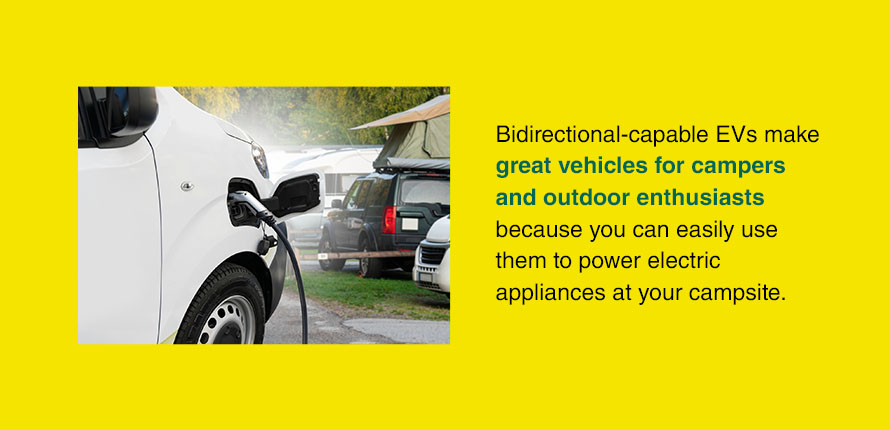
Bidirectional-capable EVs make great vehicles for campers and outdoor enthusiasts because you can easily use them to power electric appliances at your campsite. You’ll likely need to purchase additional adapters for your devices to make sure they’re compatible with your car, but it’s a worthwhile investment when you consider how much use you can get out of it.
4. Become Energy Self-Sufficient
A bidirectional-capable EV could help your home or business become self-sufficient in energy production and benefit others in your area. Using your EV to power your home or business during peak hours takes some of the burden off the grid, which helps stabilize the power supply for the rest of your community.
Incorporating energy-efficient building techniques reduces your overall energy usage, maximizing the amount of time you can use your EV to power the building. Those techniques can include:
- Passive home design
- Thermal mass materials
- Renewable energy generation through solar panels or wind power
- Proper insulation
- Optimizing energy usage during peak hours
- Reducing water consumption
- Switching to energy-efficient electrical appliances
Energy self-sufficiency is a great way to make your home more sustainable and reduce your environmental impact through renewable resources. Plus, it could give you access to tax credits and other financial incentives as governments ramp up energy conservation projects.
5. Help Other EV Drivers
Many EV drivers know the feeling of range anxiety, which is the fear of ending up in a situation where you’re running out of battery but the nearest charging station is far out of your range. Bidirectional V2V charging can help you alleviate that anxiety for yourself and your fellow EV owners.
V2V charging allows you to jump-start another EV by transferring converted AC energy from your vehicle into the recipient battery. Depending on your specific EV model, this conversion will take place either in your car’s battery or through your connecting cable.
This capability can also help business owners and fleet managers looking to optimize resource utilization among the vehicles in their fleet. For example, if one vehicle is running short on battery before a job but another is at full range, you could use V2V charging to power up the first EV enough to get the job done and get to a charging station.
Which EVs Support Bidirectional Charging?
Bidirectional charging capabilities are only available in select PHEVs and EVs. Each model typically specializes in only one or two types of bidirectional charging — for example, the Nissan Leaf and the Ford F-150 Lightning are the only models currently capable of V2H charging. Most others feature V2L charging.
The list of bidirectional-capable vehicles includes:
- Genesis GV60
- Hyundai Ioniq 5, 6 and 7
- Kia Niro
- Kia EV6 and EV9
- Ford F-150 Lightning
- Mitsubishi Outlander PHEV
- Nissan Leaf
- VW ID.4
- Tesla Cybertruck
Many EV manufacturers have announced plans to introduce bidirectional charging as a standard feature in future models, beginning with the following:
- 2024 Chevrolet Silverado EV RST
- 2024 Chevrolet Blazer EV
- 2024 Chevrolet Equinox EV
- 2024 Cadillac Lyriq
- 2025 Cadillac Escalade IQ
- 2024 Lucid Air
- 2025 Stellantis Ram 1500 REV
- 2024 Polestar 4
- 2024 Volvo EX90
Tesla has also stated it will add bidirectional charging functionality to every model in its line by 2025.
How Much Does Bidirectional Charging Cost?
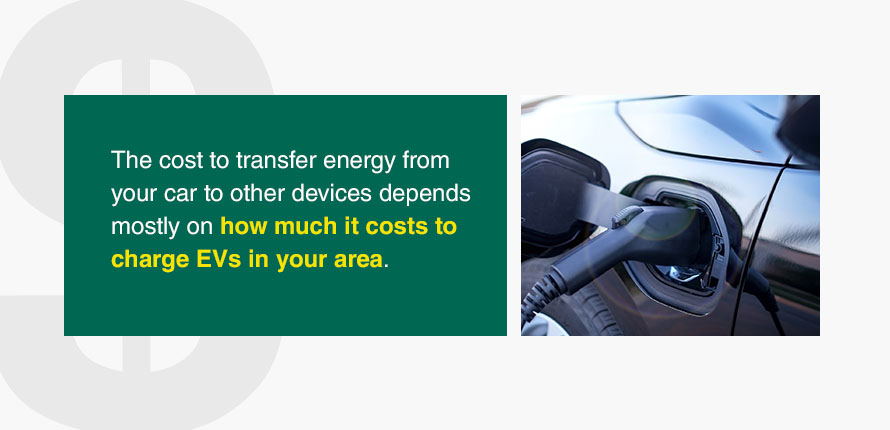
The cost to transfer energy from your car to other devices depends mostly on how much it costs to charge EVs in your area. For example, if you charge your vehicle somewhere other than your home, you might use a free public charging station. In other places, your nearest charging station will require you to pay by the kilowatt-hour (kWh), which can range from 50 cents to $1.
If you have a home charging station, though, the cost depends on how much your electricity provider charges. A home charger is a much safer option than relying on public charging stations, and it usually costs less in the long term. It’s also necessary for using V2H bidirectional charging.
Bear in mind that for most of today’s available EV models, you’ll need to purchase additional hardware or specialized chargers to tap into your vehicle’s bidirectional charging abilities. This equipment can cost anywhere from $3,000 to $10,000 depending on the brand, so be sure to do your research to find the best deal.
Some notable examples of bidirectional EV chargers that are currently available include:
- Wallbox Quasar
- Highbury
- Fermata FE-15
How Much Does Bidirectional Charging Save?
Different types of bidirectional charging have varying potential when it comes to saving money.
For example, researchers from the University of Rochester estimate that V2G-capable EVs could save owners between $120 and $150 annually in specific locations. And if you live in a place where you can get paid for V2G charging, you have the potential to make a pretty substantial return on your investment through bill credits or rebates.
V2H charging can significantly reduce your household energy bills by allowing you to take advantage of nighttime rate discounts. You can charge your EV overnight for free or for a reduced rate, then use that energy to power your home during the day instead of relying on the grid.
Essential Considerations for Buying a Bidirectional EV
Like with any investment, you want to make sure you choose a car that meets your needs and fits your budget. Some of the most important factors you’ll want to consider before you invest in a bidirectional-capable vehicle include:
- Grid compatibility: If you’re hoping to take advantage of V2G charging, you have to live in an area where the power grid is compatible with this technology. Typically, that means you need to be connected to a smart grid. Regions with older electrical infrastructure cannot yet support bidirectional charging, making you ineligible for discounts and rebates from your utility company.
- Charging type: Your EV options vary widely depending on the type of bidirectional charging you want to use. For example, if you want to use V2H charging, you have only two options — the Ford F-150 Lightning and the Nissan Leaf. But if you want to use V2L charging, you have much more freedom of choice.
- Maximum output: There is a limit to the amount of energy an EV battery can put out over a specific period of time. Be sure to check the maximum kWh your battery can supply and how certain connectors can affect this output.
- Required accessories: Will you need extra adapters to connect your EV to other electrical loads, and are these adapters included with your new vehicle? Ask your dealer to make sure before you decide on any specific model.
Call Wiretech Company for Your EV Charger Installation
Bidirectional charging is an exciting new development in the EV sphere, and with so much hype around it, it’s likely to become significantly more accessible over the coming years. If you want to install bidirectional EV chargers in your home or business, you’ll need a professional to handle the technical steps for you. That’s where we come in.
As a Referred Tesla Contractor, we at the Wiretech Company have the qualifications and expertise needed to safely and efficiently install your EV charger, and we’ll do it while providing top-tier customer service.
Ready to get started? Schedule a site visit with one of our experienced electricians today!

